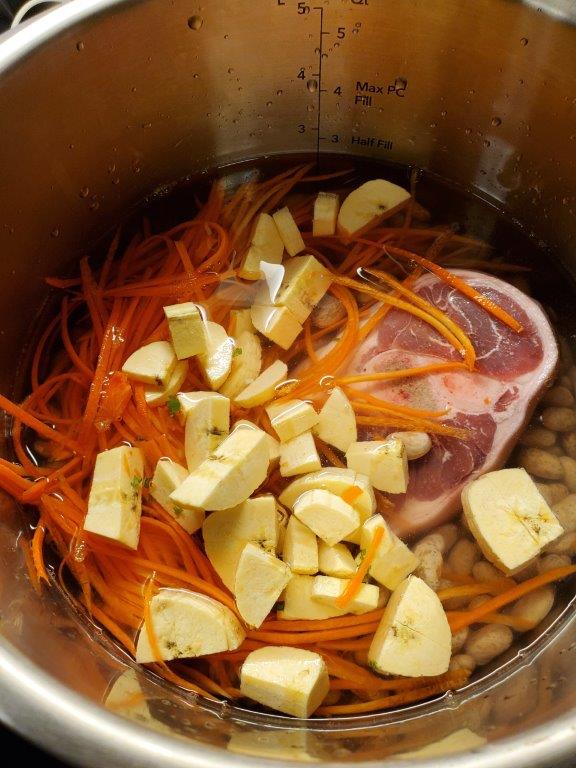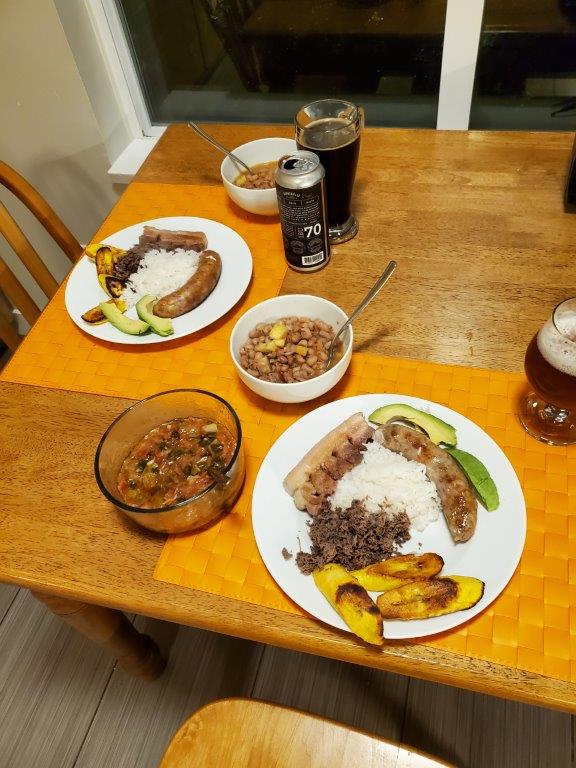We’ve finished our trip through China, although we will CERTAINLY be continuing to cook recipes from that cookbook. So now it’s time to head back to South America, and Colombia.
But first, let’s talk about Rochester, New York.
If you were unaware, Rochester’s signature contribution to world cuisine is something called “The Garbage Plate.” It consists of a bunch of stuff. On a plate. The base layer is usually a mix of starches like macaroni salad, home fries, or baked beans, topped with various forms of meat, hot sauce, and bread. It’s… a thing. They originated at a restaurant called “Nick Tahou Hots,” to which I have actually been.
Why do I bring this up?
Because the undisputed national dish of Colombia, (seriously, there’s no argument at all on this point) is something called Bandeja Paisa. Paisa is a region in Colombia, and bandeja literally means, wait for it, plate.
We’re making a Colombian garbage plate!
This dish consists of about 8 different things, combined into one delicious gut-buster of a meal. This is not a dish for sitting in an office writing applications for nuclear servicing licenses. (Oh, hey, guess what I was doing this week?) This is a dish for going out and challenging llamas to a fist fight.
So what’s on it?
Chorizo
When I went out to hunt for ingredients for this one, I was not expecting to locate Colombian chorizo on the first stop. The store seemed more touristy than ethnic, and had an (unsurprising) focus on Mexican items. But when I asked the guy behind the counter “Do you know where I can get Colombian products?” he literally reached into the fridge right next to him and pulled out this.
Clearly, the producer of this sausage has not been informed of the exciting advances in typeface design since the 1980s. I kind of love that.
Joking aside, I wasn’t a huge fan of this sausage. It had a LOT of big pieces of fat in it, and we didn’t cook it in a way that melted those out. The flavor was fine, but nothing terribly exciting.
Carne en Polvo
Literally, “powdered beef.” For this one, you “marinate” a piece of flank steak with onions, garlic, and cumin, but no liquid, for a few hours in a plastic bag.
You then boil the beef, until you have something the rough flavor and consistency of a pot roast. That gets tossed into a food processor to make a very fine, dry beef mince.
It’s somewhat reminiscent of the Seswaa we made for Botswana, but in that case the meat was returned to the pot to crisp up a bit after being pounded to a pulp. This is more soft in texture.
Chicharrón Colombiano
Pork belly! I had just made a Chinese pork belly recipe earlier in the week, but this one couldn’t be more different. For the Chinese Dong Po pork, the meat is cooked slowly in wine for hours, then refrigerated overnight, then steamed until it is falling apart tender and the fat turns to jelly.
The Colombian approach is a bit different.
First you cut slits in the meat side of the pork belly pieces.
Then you cover them with a little bit of water, cook them until the water evaporates, and then continue cooking until the pork belly is dark and crispy, and your pot is basically never going to be used for anything else ever again.

Tajadas de Plátano
Fried Plantains. Slice the plantains and quickly fry them. Done and done.
Frijoles Colombianos
Literally, “Colombian Beans.” Although it’s not traditional, we opted to make this one in an Instant Pot, just because we had so MUCH going on with this meal. And it was still a bit complicated. You soak pinto beans overnight, and then make a seasoning mix (called a “guiso”) by cooking onions, tomatoes, scallions, garlic, cilantro, and cumin.

That goes into the Instant Pot along with the beans, a ham hock, some shredded carrots, and half a green plantain.
Then, you pick the plantain back out again, because you didn’t read the recipe carefully enough. At least, that’s how WE did it. If you make this at home, you may wish to skip the last two steps.
After the beans have pressure cooked, you put the plantain back in and let it simmer for a bit to warm everything up.
Hogao
Our last major bit of prep is a condiment called “Hogao”. Unlike most of the sauces we’ve made from Central and South America, this one is cooked, rather than just being allowed to marinate. And it contains almost exactly the same ingredients as the guiso: scallions, tomatoes, garlic, cumin, salt, and pepper. But it’s cooked down to a much more soupy consistency. It’s really quite good.
Finally, it was time to bring everything to the table, along with some plain white rice, a few slices of avocado, some lime wedges, and a lack of fried egg. (Seriously, this thing should also include a fried egg, on top of everything else, but a) that was too much work, and b) I really don’t LIKE fried eggs.)
So there it is, the full Colombian Bandeja Paisa in all its glory! Although the powdered beef and beans weren’t super highly flavored by themselves, splashing them with big dollops of the Hogao was a great combination. The sausage was fatty but tasty, and the pork belly was REALLY fatty, but also REALLY tasty, as long as you didn’t think about the cleanup. The plantains were a nice break from the heaviness of everything else.
Definitely higher on my “eat again” list than going back to Nick Tahou’s. (Sorry, Rochester!)
All of these recipes are from the site “My Colombian Recipes.” I’ll link the master “Bandeja Paisa” recipe, and it links through to all the sub-recipes. Next up, the tiny island nation of Comoros!
Recipe: Bandeja Paisa









